Search Results for Tag: sea ice
The Arctic on the UN agenda
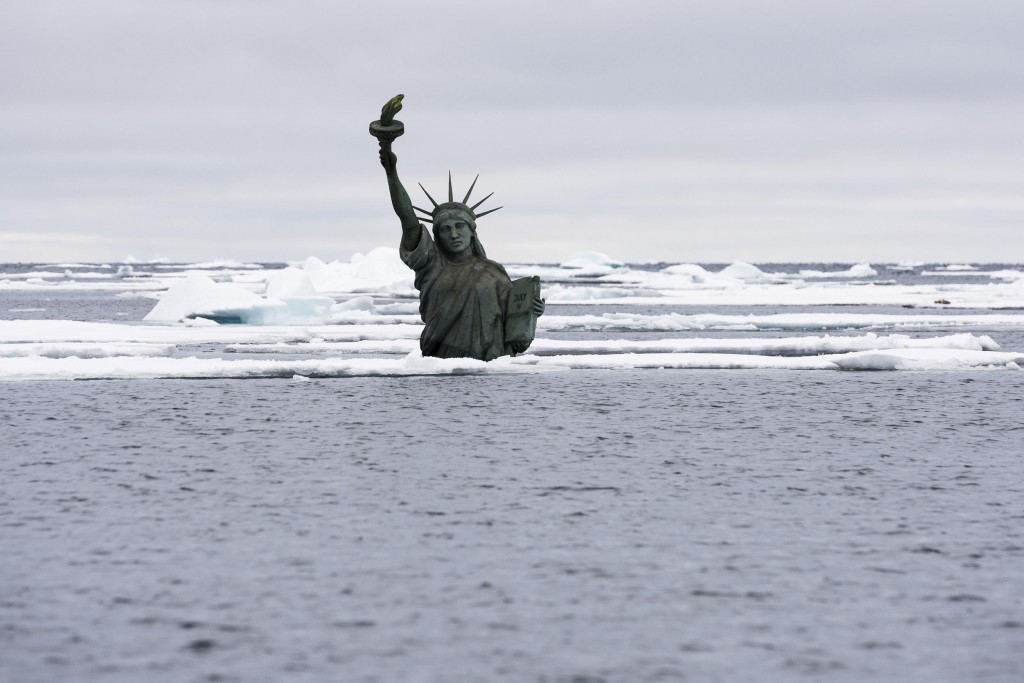
US icon sinking in melting ice? The photo was taken in the Arctic Ocean northwest of Svalbard the 7th of September 2014.
(Christian Auslund / Greenpeace)
To those of us who deal with the Arctic on a regular basis, the significance of the melting ice for the UN climate negotiations and vice versa is abundantly clear. But not everybody understands all the connections. A major media event like this week’s New York climate summit hosted by the UN Secretary General Ban Ki Moon in person was a fine chance to focus attention on the need to protect the Arctic. Greenpeace made good use of it, handing over a petition with six million signatures just ahead of the big event, and with hundreds of thousands gathered in New York for the Climate March.
It was timely in more ways than one, just as the latest sea ice figures were published to confirm the melting trend.
The petition calls for long-term protection of the Arctic, with the region warming more than twice as fast as the global average and opening the high north to shipping and commercial exploitation. Greenpeace and other groups are calling for a ban on oil exploration, which could endanger the fragile ecosystem. Experts also have safety concerns about increased shipping.
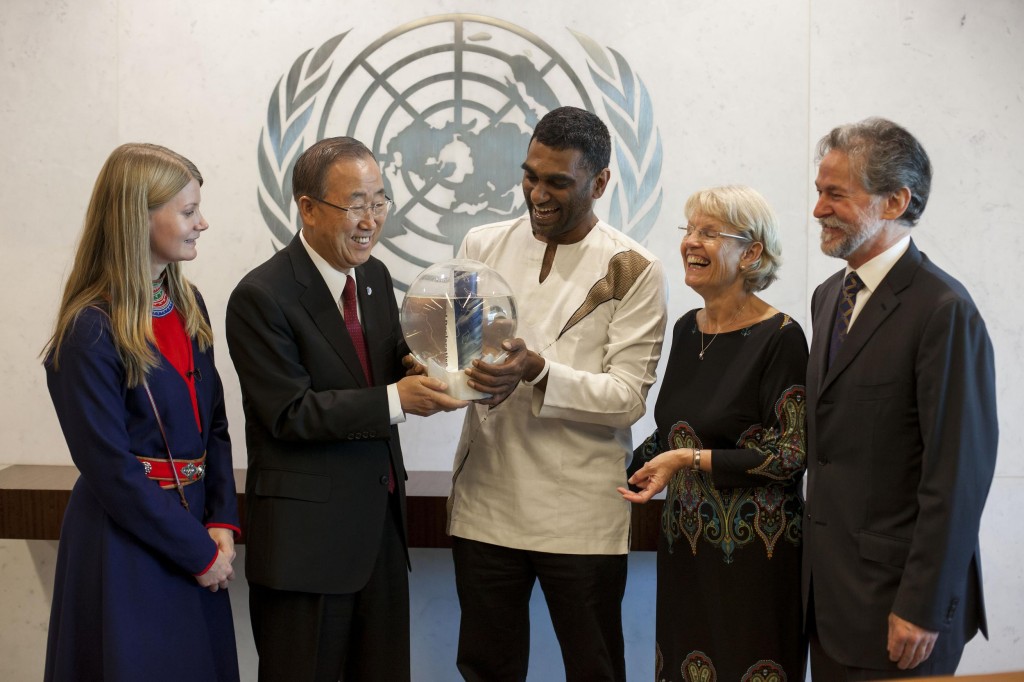
Ban Ki-moon receives the Greenpeace delegation with the petition. The delegation consists of Indigenous rights activist, youth leader and Saami politician Josefina Skerk, Margareta Malmgren-Koller, Greenpeace Senior Political Advisor Neil Hamilton and Greenpeace International Executive Director Kumi Naidoo. Photo: Michael Nagle / Greenpeace
Commercial development versus environment
Earlier this month, a survey showed that 74% of people in 30 countries support the creation of a protected Arctic Sanctuary in the international waters surrounding the North Pole. The study was commissioned by Greenpeace and carried out by Canadian company, RIWI. Around the same time, the Arctic Council, which combines the Arctic states and indigenous peoples’ representatives, currently chaired by Canada, supported the founding of a new business grouping, the Arctic Economic Council. Its aim is to promote the commercial development of the Arctic region. I wrote about this here on the Ice Blog and on the DW website.
Global responsibility for the Arctic
The UN Secretary General accepted the Greenpeace petition saying:
“I receive this as a common commitment toward our common future, protecting our environment, not only in the Arctic, but all over the world.”
Ban Ki-moon said he would consider convening an international summit to discuss the issue of Arctic protection. He also expressed a desire to travel aboard one of the organisation’s campaigning ships in the Arctic in the near future.
Greenpeace Executive Director Kumi Naidoo, who was part of the delegation, said: “The Arctic represents a defining test for those attending the summit in New York”.
He said leaders should bear in mind that concern for the rapid warming of the world was not consistent with planning oil and gas development in the melting Arctic.
The small delegation that met Ban Ki Moon included Indigenous rights activist and Saami politician Josefina Skerk, who last year trekked to the North Pole to declare the top of the world ‘the common heritage of everyone on earth’.
Skerk, a member of the Saami Parliament, said: “We, who want to continue living in the North, are gravely concerned about climate change and the destructive industries that are closing in. My people know and understand the Arctic, and it is changing in a manner, which threatens not just our survival, but the survival of people all over the world.”
Skerk said humans had created the crisis and had to take action to solve it.
“I urge the Arctic countries in particular to take a giant step up and I think the world needs to pay much closer attention to ensure that it happens. They might as well start here in New York.”
From Kiribati to Svalbard and New York
Melting ice especially from the Arctic Greenland ice sheet is raising sea levels around the globe, endangering low-lying areas. At the weekend, the President of Kiribati, Anote Tong, ended a Greenpeace-organized tour of glaciers in Norway’s Svalbard Archipelago. He said the trip to the Arctic ice had made a deep impression on him, which he would share with world leaders at the U.N. climate summit:
“It’s a very fascinating sight. In spite of that, what I feel very deeply is the sense of threat,” Tong said. “If all of that ice would disappear, it would end up eroding our shores.”
Kiribati is a group of 33 coral atolls located about halfway between Hawaii and Australia. Many of its atolls rise just a few feet above sea level.
In last year’s report by the Intergovernmental Panel on Climate Change (IPCC), experts concluded oceans could rise by as much as 1 meter (3.3 feet) by the end of this century if no action is taken to cut the greenhouse gas emissions causing global warming.
“It won’t take a lot of sea level rise to affect our islands,” Tong said. “We are already having problems.”
Sea ice minimum confirms melting trend
The New York summit coincides with the annual announcement of the minimum sea ice for the year, as the summer season comes to an end. The sea ice – in contrast to glaciers on land – does not influence global sea level, but is regarded as a key indicator of how climate change is affecting the region. This year the figure announced by the US National Snow and Ice Data Centre (NSIDC) was 5.01 million square kilometers. The figure is the sixth lowest extent since records began.
The minimum ever recorded at the North Pole was 3.29m sq km in 2012 – and the eight lowest years have been the last eight years.
Ice levels in the Arctic have recovered from their all-time low, but are still on a shrinking trend, said Julienne Stroeve of the National Snow and Ice Data Centre. ”We have been telling this story for a long time, and we are still telling it,” she said.
NSIDC records showed that, this year, ice momentarily dipped below 5million sq km to 4.98m on 16 September, but the official figure is taken from a five day average.
Satellite data shows that one part of the Laptev Sea was completely clear from sea ice for the first time this summer. One of the most important questions for climate scientists is how soon the Arctic will experience its first sea ice-free summer.
Rod Downie, head of WWF UK’s polar programme, said that this year’s new Arctic minimum should prompt new action from the leaders meeting in New York. He stressed the connection between the Arctic and weather conditions in other parts of the world:
“As David Cameron prepares to meet other global leaders at the UN climate change summit in New York, the increased frequency of extreme weather that is predicted for the UK as a result of a warming Arctic should serve as a reminder that we need urgent action now to tackle climate change,” he said.
The summit was a major PR event to draw attention to the need for urgent and substantial climate action. The accompanying protests around the globe show people are not happy with the slow pace of the climate talks and their governments’ efforts to reduce emissions. Of course there was little in the way of concrete pledges. Still, on the whole, I see it as a successful step on the way to a new climate agreement because it has put the spotlight on climate change at a time where international conflicts are dominating the news agenda.
More commentary on the summit from me here:
World leaders must act as climate takes centre stage
All-star gala puts climate back on the agenda
Arctic Economic Council – and the environment?
I would like to share my thoughts with you on the founding meeting of the Arctic Economic Council, taking place in Canada Sept. 2nd and 3rd. Iqaluit, the capital of the northern Canadian territory of Nunavut, is hosting the inaugural meeting of the, group set up to promote commercial development in the Arctic, as climate change makes the region more accessible. It was in Iqaluit that the first-ever ministerial meeting of the Arctic Council (AC) took place back in 1998. The newly established independent Arctic Economic Council (AEC), with close links to the AC, could prove to be equally influential.
Canada currently holds the rotating presidency of the Arctic Council, an organization linking eight Arctic states and six organizations representing Arctic indigenous peoples. Its self-set tasks include sustainable development, monitoring the Arctic environment, identifying pollution risks and environmental emergency preparedness. But in the race to open the Arctic to increased shipping, oil and gas exploration and mining, the formation of the new Arctic Economic Council (AEC) could see commercial interests gaining the upper hand.
Canada puts business first
Leona Aglukkaq, Canada’s Minister for the Environment, the Canadian Northern Economic Development Agency and the Arctic Council, is presiding over the founding meeting of the AEC. Its creation has been a key project during Canada’s 2013-2015 Arctic Council chairmanship, which Aglukkaq has focused on “development for the people of the North.”
“Our government prioritized the creation of the Arctic Economic Council to facilitate business opportunities, trade, investment and growth in the best interests of Northerners,” said Aglukkaq ahead of the two-day meeting. “Establishing this body is an historic moment for the Arctic Council in its efforts to advance sustainable development in the Arctic. I’m confident that the AEC will be a strong and effective body that will help enhance pan-Arctic economic cooperation for the benefit of communities and people in the Arctic.”
An unwise move for the AC?
But some people believe the AC could be making a mistake by allowing a potentially highly influential business group to grow outside of its own structures. Neil Hamilton, Senior Polar Political Advisor at Greenpeace International, told DW: “By creating an independent organization which answers to no one but has the authority to attend, work within, and manipulate the activities of the Arctic Council and its working Groups, the Arctic Council has severely undermined its own mandate.”
The AEC is being established with the contribution of the Arctic Council, but as an independent body. Representatives of both Councils would meet at regular intervals to discuss the economic development of the Arctic.
Originally, the AEC was envisaged as a circumpolar business forum. It’s since turned into a more formal structure. Each of the member states and each of the council’s indigenous permanent participant organizations was invited to send a maximum of three representatives to the inaugural meeting, where they will discuss the organization, structure and objectives of the AEC. The business representatives attending include CEOs and other high-ranking figures from a range of industries including oil and gas exploration, iron mining, tourism and shipping lines.
In the future, membership will not be limited to these nominations and may accept self-nominations from the Arctic business community.
A back-seat for the environment?
Canada says businesses in the Arctic will play a strong role in building a sustainable and economically vibrant future for the region. This will not reassure environment campaigners who have repeatedly attacked the current Canadian administration for its support of environmentally problematic industries such as oil tar sands or fracking, and for its refusal to back international climate agreements. The participation of the Vice-President of Russia’s Rosneft Oil Company Andrey Shishkin will raise eyebrows among those concerned about the possible environmental impact of oil exploration in the High North.
Finland is seeking to chair the AEC, although the group is to be purely business and not government run. In a press release, the country’s Foreign Ministry mentions environment protection but does not appear to give it priority when it outlines the objectives of the new body:
“In the future, the main focus of its work will be on the enhancement of the economic operating conditions of indigenous peoples and Small and Medium Enterprises (SMEs), the reduction of obstacles to trade, the support for sustainable economic operations, and raising of issues the AEC itself considers topical.”
In an AC paper on “facilitating the creation of the Arctic Economic Council,” environmental protection is only listed the last of six objectives, in connection with “maximizing the potential for Arctic economic activities.”
Conservationists are concerned that protecting the environment could take a back seat while companies pressure for fewer restrictions. With the Arctic warming more than twice as fast as the rest of the world and melting ice easing access to northern regions, the pace of Arctic development could outrun efforts to ensure environment protection and safety measures with increasing shipping and the risk of accidents or oil spills.
The World Wildlife Fund, which originally supported the group, told journalists the way it had been set up was “opaque and unaccountable”. WWF said it hat been refused permission to observe the meeting.
Greenpeace Arctic policy advisor Hamilton told DW: “The founding document of the Arctic Economic Council sets the frame for a new era of exploitation of the Arctic, without any indication of intent to protect the environment.” At the same time the Arctic Council, which was established to protect the environment, was “negating its prime function.”
Hamilton called on the Arctic Council to accord civil society the same privilege as it appears to be allowing the new economic group, by loosening regulations on granting the role of observer status.
The two-day meeting in Iqaluit ends on Wednesday, September 3rd. In the coming months, the Arctic Council will have to clarify its relation to the new AEC it helped create, and demonstrate how it’s going to reconcile the increasing pressure for commercial activity with avoiding environmental damage.
Arctic methane: time bomb or “boogeyman”?
When the Ice Blog was launched in 2008, one of the first posts from a trip to Alaska entitled “Ice-Capades and Alaska baking with methane?” included a visit to frozen-over “Eight-mile Lake” in the Denali national park, where scientists Katey Walter and Laura Brosius were measuring methane emissions from melting ice and permafrost. The young “climate ambassadors” I was travelling with helped her to set up “umbrella traps” and capture bubbles of methane coming to the surface. The “proof of the pudding” was setting a match to the gas and watching it catch light. An interesting experiment. But the subject has huge wide-ranging implications. Methane is also a greenhouse gas 25 times more powerful than CO2. Walter and others have since recorded numerous methane seeps in Alaska and Greenland. As global temperatures increase, the permafrost thaws, potentially releasing the gas stored both in the permafrost on land and in the form of methane hydrates under water.
Since that Alaskan trip, methane has beconme an increasingly “hot topic”, with more research being conducted and data collected. The reservoir of methane stored under the Arctic ice and permafrost is huge. And there is increasing scientific evidence that with the world warming, this reservoir is not going to stay there for ever. The concentration of atmospheric methane has increased dramatically in the last 200 years – especially in the Arctic. In 2008, scientists came up with a scenario where up to 50 gigatonnes of methane could be released abruptly from the East Siberia Arctic Shelf (ESAS) because of the melting of permafrost which had hitherto kept it safely sealed in.
Fountains of methane
In 2011, a joint US-Russian expedition surveying the seabed of the East Siberian Arctic Shelf off northern Russia was surprised to observe fountains of methane rising to the sea surface from beneath the seabed. At that time, scientists expressed concern that with the melting of Arctic sea ice and permafrost, the huge methane stores might be released over a relatively short period of time.
The SWERUS-C3 expedition headed by Örjan Gustafsson from Stockholm University is currently underway in the Laptev Sea, where they have discovered “vast methane plumes escaping from the seafloor of the Laptev continental slope”. Gustavsson writes in his blog that he was surprised by this. He speculates that it could have its origins in collapsing “methane hydrates”, clusters of methane trapped in frozen water due to high pressure and low temperatures.
“While there has been much speculation about the vulnerability of regular marine hydrates along the continental slopes of the Arctic rim, very few actual observations of methane releases due to collapsing marine hydrates on the Arctic slope have been made”, Gustafsson writes. He thinks a “tongue” of relatively warm Atlantic water, presumably intruding across the Arctic Ocean at 200-600 meters depth could have something to do with the methane seeps. Some evidence shows this water mass has recently become warmer.
“As this warm Atlantic water, the last remnants of the Gulf stream, propagates eastward along the upper slope of the East Siberian margin, it may lead to the destabilization of methane hydrates on the upper portion of the slope”, Gustafsson writes.
Costly bubbles
In 2013, a paper published in the journal Nature put a price tag on the possibility of the Arctic’s methane being released. The experts suggest it could trigger costs of 60 trillion US dollars. Normally, as soon as money is involved, public interest tends to rise. The report should really have brought the subject of “Arctic methane hydrates” out of the science corner onto the economic and political agenda. Which is, of course, where it has to be, if there is any chance of limiting the Arctic thaw by halting global warming.
There are scientists who insist that such a scenario is not likely. Let me refer you here to a detailed analysis of the scientific literature on the subject published by Nafeez Ahmed, executive director of the Institute for Policy Research & Development, in EarthInsight hosted by the Guardian, in 2013. He points out that none of the scientists who reject the plausibility of the scenario are experts in the Arctic, and specifically the ESAS. On the other hand, there is an emerging consensus among ESAS specialists based on continuing fieldwork, he writes, “highlighting a real danger of unprecedented quantities of methane venting due to thawing permafrost”.
Rhetoric, polemics – but accuracy please!
Ahmed comes down on the side of the Arctic experts who are highly concerned about the risk of methane being set free in large quantities. That is already clear from the title of his article “Seven facts you need to know about the Arctic methane timebomb”. Sub-headed: “Dismissals of catastrophic methane danger ignore robust science in favour of outdated mythology of climate safety.” Yes, you could say that is tendentious. It is certainly rhetorically powerful.
Perhaps that accounts in part for the reaction I got when I tweeted the link to his analysis recently as interesting background to the ongoing debate on Arctic methane. One response told me to stop “fear mongering” and referred to an article describing methane as a “climate boogeyman”. (In connection with studies on methane leaks from natural gas production). Aha. Emotions are running high – on both sides.
Still – Ahmed’s article is based on a thorough analysis of both sides of the arguments. It seems this cannot be said of a piece on news.com.au, headlined “Are Siberia’s methane blow-holes the first warning sign of unstoppable climate change?”. The article links three giant craters which have been found in Siberia to the scientific research of Jason Box, a renowned glaciology professor and Greenland expert, starting with the tantalizing question:
“What do three enormous craters in the Siberian wastelands have to do with a terrified American climate scientist? Methane. And that’s something to scare us all”.
In fact, as Jason Box @climate_ice tweeted to his followers, the Arctic expert’s research and concern have nothing to do with the giant craters. He tweets:
“News piece juxtaposes Siberian holes with my carbon release concerns but I have no idea about the holes”
Citing the concerns and findings of reputed scientists alongside other reported explanations of the Siberian craters as “hellmouths”, “gateways to the undead” or “aliens” does nothing for serious scientific attempts to monitor climate change in the Arctic or inform politicians and businesses about the scenarios for which the world has to prepare. Now if those of a skeptical persuasion were to take this kind of article as “fear mongering” or the “climate boogeyman”, I could just about understand it. Please, let us not detract from the value of scientific monitoring and analysis, complex computer modeling and genuine concern on the part of a lot of experts who know very well what they are talking about. And let us not bring the media into disrepute for misrepresenting the views of scientists like Jason Box by taking his findings and statements out of context in the interest of a sensationalist story. We do not need to mix fact with fiction and create “boogeymen”. The huge body of scientific findings out there is already scary enough.
Emperor Penguins in Distress
It has been a busy week for me here at DW, and unfortunately I was not able to do justice to the latest research on the likely fate of the Emperors down at the far south of the planet in the form of some interviews or a detailed article. Before I head off to a seminar tomorrow, I want to make sure the Ice Blog does not neglect our majestic friends in the Antarctic. Fortunately, Tim Radford from the Climate News Network has summed up the story: ” Loss of Antarctic sea ice through climate change threatens the emperor penguin’s habit to such an extent that scientists say it should now be made an iconic symbol – like China’s endangered giant panda – of the wildlife conservation movement” . Thanks Tim, Alex and all at the Climate News Network who keep us up-to-date on so many important climate issues. Thanks also to Dave Walsh for alerting to me to this study which, I am pleased to say, made its way into a lot of media outlets, if only briefly. Thanks also to Dave for the Belgian International Polar Foundation picture.
Allow me to quote at length from Tim’s summary:
“Global warming will this century take its toll of Antarctica’s most regal predator, the emperor penguin. There are now 45 colonies of this wonderful bird, but by 2100 the populations of two-thirds of these colonies will have fallen by half or more.
Stéphanie Jenouvrier, a biologist at the Woods Hole Oceanographic Institution in the US, and colleagues from France and the Netherlands report in Nature Climate Change that changes in the extent and thickness of sea ice will create serious problems for a flightless, streamlined , survival machine that can live and even breed at minus 40°C, trek across 120 kilometres of ice, and dive to depths of more than 500 metres. The researchers took all the data from 50 years of intensive observation of one colony in Terre Adélie and used climate models to project a future for the other 44 colonies known in the Antarctic.
Decisive factor
They found that the decisive factor in emperor penguin survival was the sea ice. If the seas warmed and there wasn’t enough ice, then that affected the levels of krill in the southern ocean, and therefore reduced the available prey. It also made the penguins more vulnerable to other predators. If the opposite happened and there was too much sea ice, then foraging trips took longer and penguin chicks were less likely to survive.
Aptenodytes forsteri – the Linnean name for the emperor – is not in trouble yet, and its numbers may even grow in the years up to 2050. But this growth won’t last, and decline is likely everywhere. Climate change has already begun to affect penguin species much further north, in Argentina, by taking toll of young chicks.
Endangered class
For different reasons, the average rise in global temperatures forecast by the Intergovernmental Panel on Climate Change (IPCC) could push the emperor into the endangered class.
“If sea ice declines at the rates projected by the IPCC climate models, and continues to influence emperor penguins as it did in the second half of the 20th century in Terre Adélie, at least two-thirds of the colonies are projected to have declined by greater than 50% from their current size by 2100,” Dr Jenouvrier said. “None of the colonies, even the southernmost locations in the Ross Sea, will provide a viable refuge by the end of the 21st century.”
The researchers end their paper by arguing that the emperor should – like the giant panda in China – become an icon for the conservation movement. They conclude: “We propose that the emperor penguin is fully deserving of Endangered status due to climate change, and can act as an iconic example of a new global conservation paradigm for species threatened by future climate change.” – Climate News Network.
– Yet another worrying piece of evidence on how human-made climate change is threatening the biodiversity of the planet, even in that “last bastion” of the Antarctic. The question is whether those iconic examples of species under threat from climate change like the penguins and their northern counterparts the polar bears are doomed to disappearance or whether their plight can really prompt the kind of lifestyle change and political and economic turnaround we need to put the brakes on climate change. I wish I could say I felt optimistic and had heard more than a lot of sympathetic “awwww”s in response to this latest distressing piece of penguin news.
See also:
West Antarctic Ice Sheet collapse unstoppable
Climate Risk to Icy East Antarctica
Ice Blog Post: Will the Antarctic share the Arctic’s Fate?
First World Wildlife Day and the Arctic
Maybe like me you were not aware that up to now there had been NO World Wildlife Day. Sometimes I have the feeling every day on the calendar must have been designated the day of several different causes. In fact, the UN only decided in 2013 that March 3rd 2014 should be the first World Wildlife Day. As I have commented on similar occasions here on the Ice Blog, the danger of these “international day of whatever” events is that the inflation can actually detract attention. Nevertheless, these designated days can be an opportunity to focus on particular topics. World Wildlife Day is a fine chance to remind ourselves once again of the need to protect biodiversity, especially in such a key region as the Arctic, which is being affected so drastically by climate change.
The Convention on Migratory Species of Wild Animals (CMS), a UN body with its headquarters in Bonn, plays a key role in wildlife protection. Given that animals do not recognize human-designated national borders, wildlife protection has to involve international cooperation, which is what CMS does. Bradnee Chambers is the Executive Secretary of CMS. He gave me this message for the Ice Blog on World Wildlife Day, focusing on that most famous of all Arctic creatures, the polar bear :
“The Arctic is extremely fragile and changes to its ecosystem from climate change will have irreversible consequences on migratory species such as the polar bear. We must stabilize global green gas emissions before the polar bear literally loses the very ice beneath its feet.” I can only wholeheartedly agree. And what is true of the polar bear, is true of so many other species. Let me quote at length from an article Bradnee Chambers has written:
“The largest terrestrial predator on Earth is losing the ground under its feet. Polar bears used to dominate the expanse and loneliness of the Arctic, which can seem unaffected by human presence so far. However, appearances deceive. The polar bear is now a symbol if the many species whose survival is at risk because of the effects of climate change and pollution.
The antics of Knut the polar bear cub in the Berlin Zoo touched the hearts of the German public and won him fans all over the world. The polar bear might look cute and cuddly, making it a perfect icon for Coca-Cola and many other organizations that wish to use its iconic recognition value to promote their cause or product. It is, in fact, a ferocious predator that spends much of each year on the sea ice hunting and, in the process, covers distances of up to 620 miles (1,000 kilometers). But the polar bear is also a vulnerable species listed on the International Union for Conservation of Nature’s (IUCN) Red List — one that requires constant attention and sound conservation management humanity is to ensure the polar bear’s existence for future generations.
There have long been concerted, international efforts to conserve the polar bear, and the Polar Bear Agreement meeting in Moscow in December 2013 celebrated 40 years of collaboration among the five nations where polar bears exist — namely Canada, Greenland (an autonomous community that is part of Denmark), Norway, the Russian Federation and the United States. The meeting attendees agreed on a declaration promising to beef up the monitoring of these animals and the assessment of their status, and to commit to working toward developing a polar bear action plan for the next meeting of these countries in two years’ time.
Nevertheless, these countries admitted in 2009 that climate change was the main threat that needed to be tackled. Early indications from that time were that the individual conservation efforts of the five countries were beginning to bear fruit, with most polar-bear populations at least stable — with a total of 20,000 to 25,000 individuals in the wild. But all of these hard-won advances could easily be lost if Arctic ice continues to diminish.
The Convention on Migratory Species (CMS) and its Scientific Council have been examining the effects of climate change on migration for years and, in 2011, passed an unequivocal resolution — “Migratory Species Conservation in the Light of Climate Change” — identifying the polar bear as one of the species most threatened by climate change. (…)
Climate change, which is leading to reduced ice cover and the thawing of permafrost, is not the only factor having detrimental effects on polar bears. Increased economic activities, such as oil and gas exploration and exploitation, and shipping, are also taking their toll. As apex predators, polar bears are vulnerable to environmental pollutants, and post-mortems have shown dangerous levels of mercury and other toxins in the animals. These pollutants even affect newborn cubs, which ingest the poisons in their mothers’ milk. Governments have to strike a fine balance: How are they to protect a fragile environment and forsake economic opportunities while exploiting much needed natural resources and creating jobs and wealth? The choices made often make the prospects for the polar bears bleaker, with fewer places for them to hunt and build dens in which to raise their young. The CMS is a global treaty whose parties have committed to working together to conserve the hundreds of species listed on its appendices. These range from the blue whale to the monarch butterfly to gorillas, whose territories straddle the borders of the Democratic Republic of the Congo, Rwanda and Uganda, and the arctic tern, which covers hundreds of thousands of kilometers in a lifetime in its pole-to-pole migrations. As a worldwide convention, CMS has the breadth to deal with species such as the polar bear in the context of climate change, adding a global perspective to conservation policies. The convention is used to dealing with multiple threats — such as pollution, climate change and environmental degradation — and it is recognized as the Convention on Biological Diversity’s lead partner on the conservation and sustainable use of migratory species. It has a catalog of more than 30 years’ worth of wide-ranging policies and a track record of fostering international cooperation.
At the International Forum on the Conservation of Polar Bears — which was held in December and attracted high-level participation, including from Russian Environment Minister Sergei Donskoi and his Canadian counterpart, Leona Aglukkaq — delegates were confronted with a disturbing prediction: The polar-bear population could fall by as much as two-thirds by 2050. Nations need to take action now, and the bears need all the friends they can get. CMS is ready to play its part if its parties agree to include the polar bear under its appendices.”
Bradnee Chambers’ article is available in full on LiveScience.
In a video message to mark World Wildlife Day, UNEP chief Achim Steiner says wildlife is too often thought of as a threat to development. He stresses that it is not just the big iconic animals we need to worry about. He stresses how biodiversity is essential to support life on earth. This biodiversity is under threat from climate change and pollution all round the globe – and especially in the rapidly changing and developing Arctic.



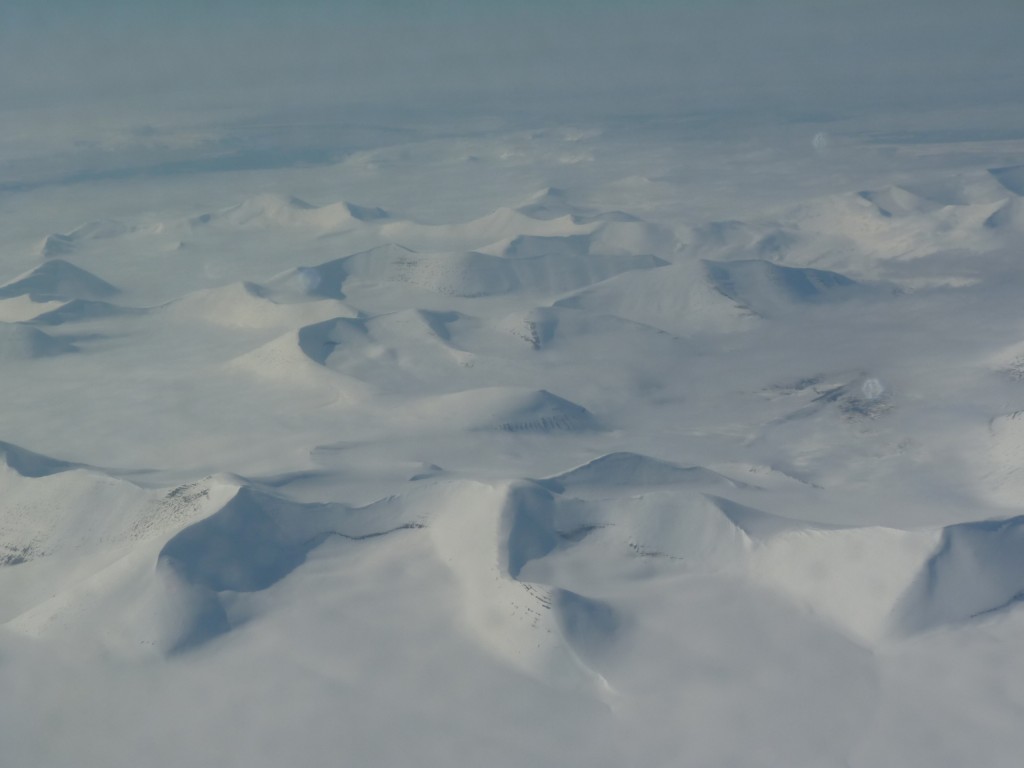

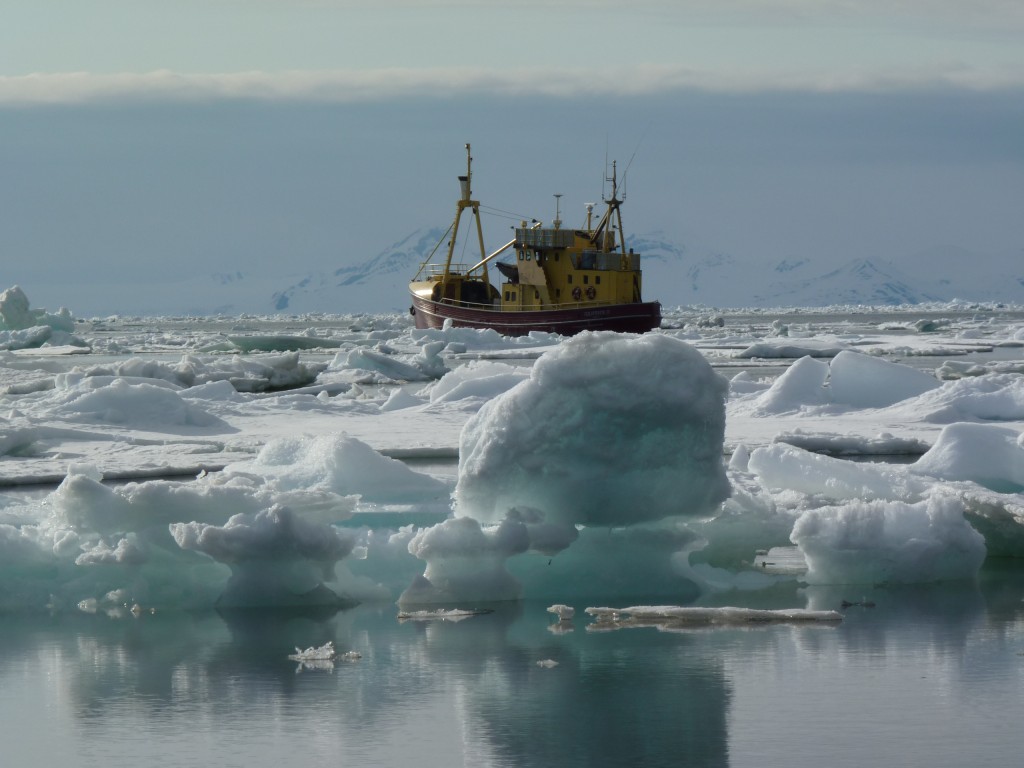
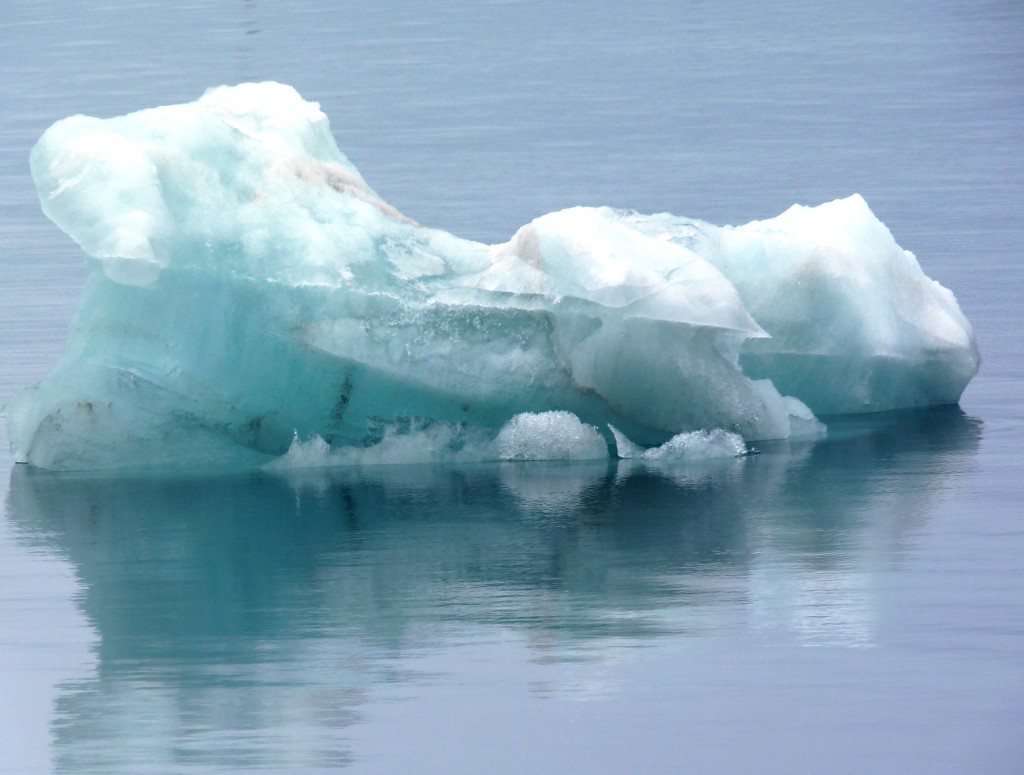
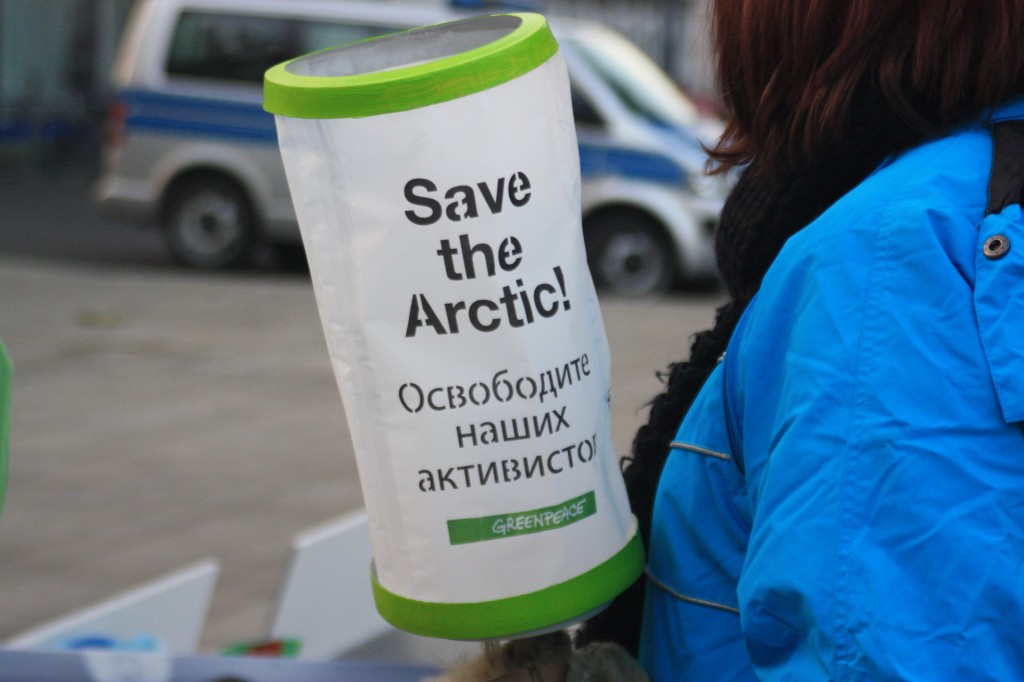
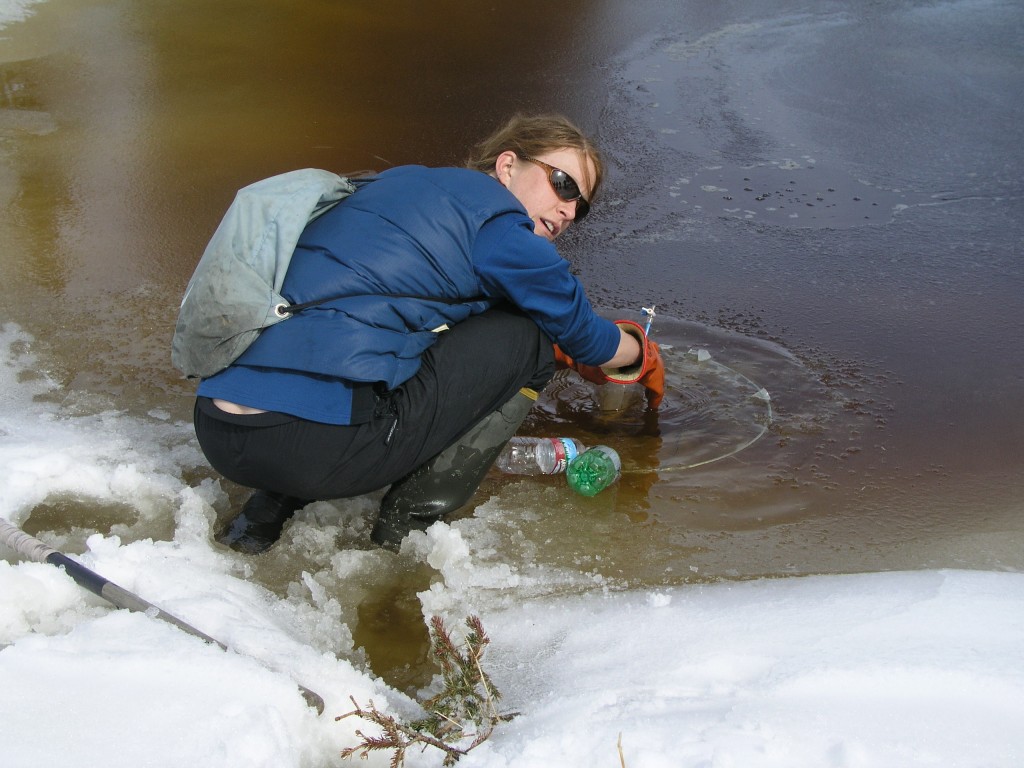
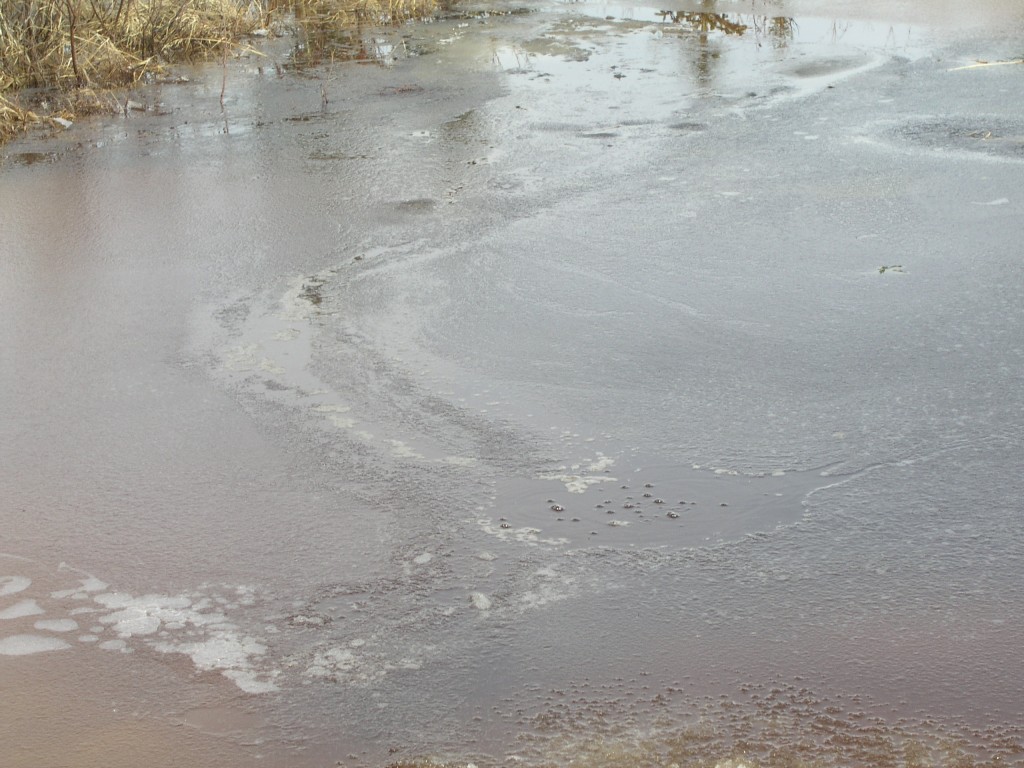
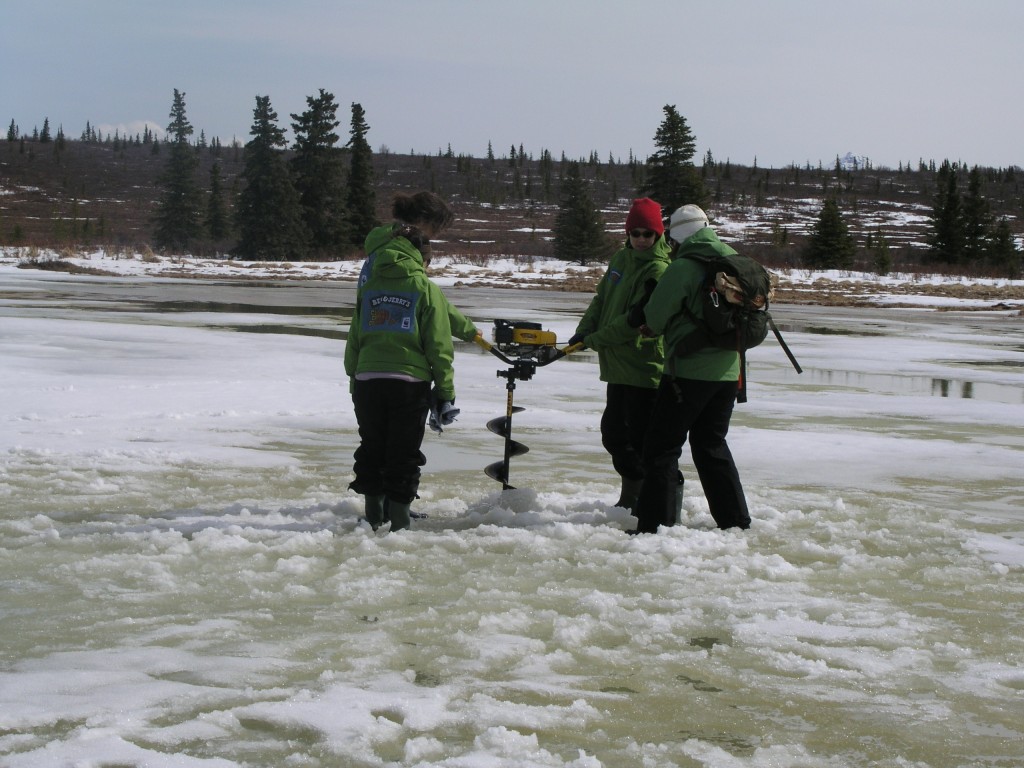
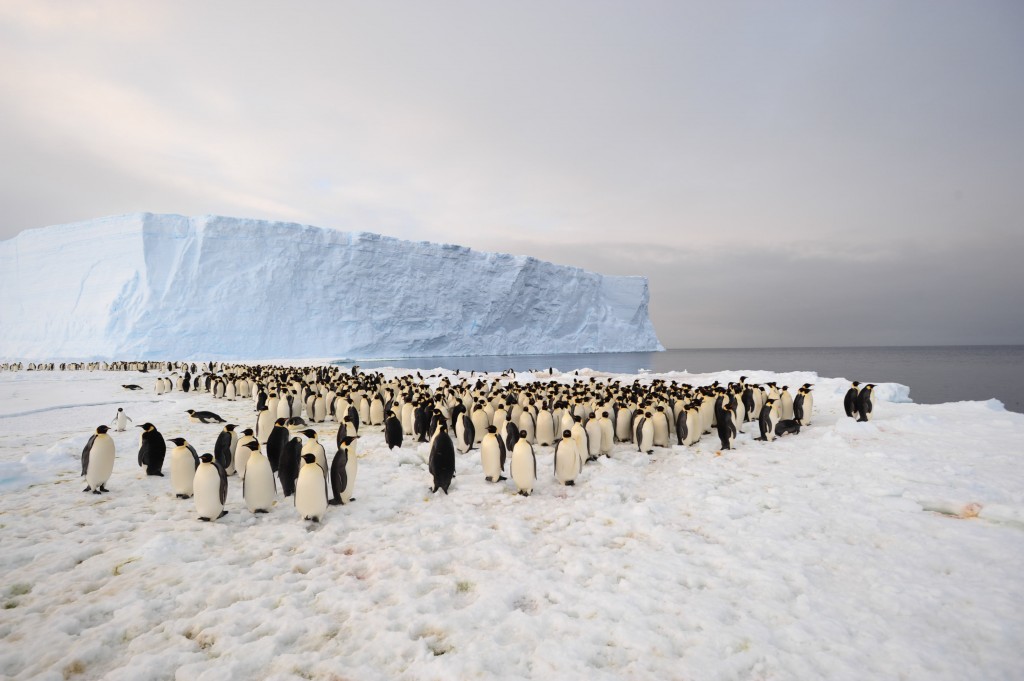
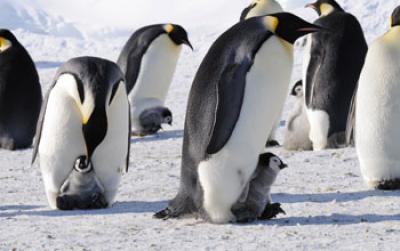
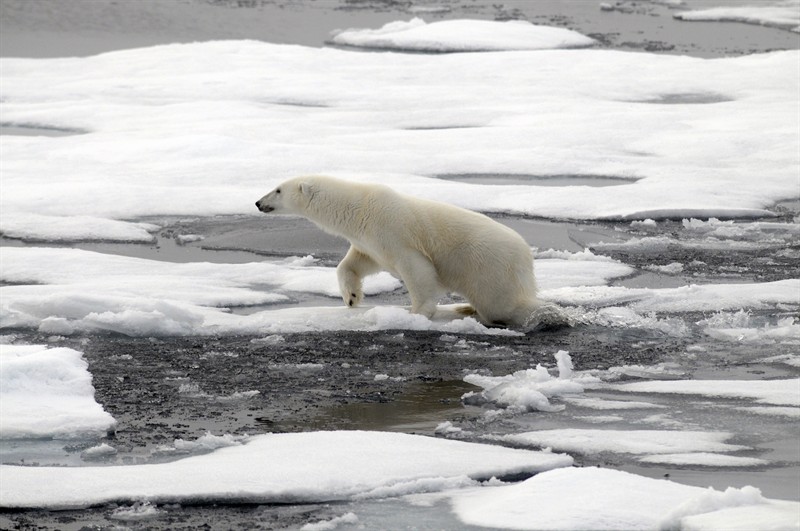
















Feedback